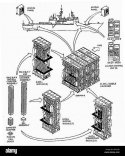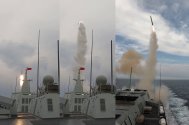Definitely not a YJ-18A and it looks too slow for an HQ-9. Also it appears to be hot-launched.YJ-18A or HQ-9, the camera is from a different angle.
You are using an out of date browser. It may not display this or other websites correctly.
You should upgrade or use an alternative browser.
You should upgrade or use an alternative browser.
055 DDG Large Destroyer Thread
- Thread starter FarkTypeSoldier
- Start date
- Status
- Not open for further replies.
Definitely not a YJ-18A and it looks too slow for an HQ-9. Also it appears to be hot-launched.
The smoke hides the missile's profile but that should be a YJ-18.
The speed, agility, and plume appear to be sigificantly different than the YJ-18A launched at 0:32. Compare the plum there to 0:32. Very different.The smoke hides the missile's profile but that should be a YJ-18.
The speed, agility, and plume appear to be sigificantly different than the YJ-18A launched at 0:32. Compare the plum there to 0:32. Very different.
I think its just different camera angle and distance.
<cough>
(forgive the music)
One could be forgiven for thinking China bought the HQ-10 from Raytheon.
HQ-10 being a copy of RAM is very old news. While the individual components and systems are not the same, the basic mode of operation is, using infrared seeker and a passive seeker with two interferometer horns.
Compare the size and intensity of the flame and the density and color of the smoke.
View attachment 82822
The tail end of the missile at the left and at the right, confirms its a YJ-18. That's how the YJ-18 booster looks.
The tail of the missile on the left is different than that on the right. The one on the right is a YJ-18A. The one on the left is using, very obviously, a different booster. I'd think it was an HQ-9 but then they're cold launched and the motor would yet to have started when we first see the left missile.The tail end of the missile at the left and at the right, confirms its a YJ-18. That's how the YJ-18 booster looks.
The tail of the missile on the left is different than that on the right. The one on the right is a YJ-18A. The one on the left is using, very obviously, a different booster. I'd think it was an HQ-9 but then they're cold launched and the motor would yet to have started when we first see the left missile.
The one on the left is the HQ-9. On the 055, the HQ-9 is typically fired from the front and the YJ-18 at the rear, which is different from the 052D where the HQ-9 and YJ-18 are fired from the front, with the YJ-18 at VLS blocks 3 and 4, and HQ-9 only at the rear VLS.
A new missile would be interesting to see, but absolutely clear picture is demanded to remove all doubt and possible counter explanation.
All cells on Burkes/Ticos are the Strike Length. (The largest cell.) That was the standard, and what is required to fit a Tomahawk cruise missile. The smaller cells were designed so smaller ships could still use the VLS for things like SM-2 and ESSM.
I am saying that canister and cell length are two different things. SM-2MR, ASROC and ESSM uses a smaller 228" canister while Tomahawk, SM-2ER, SM-3 and SM-6 uses the longer 302" canister. The shorter canister will fit the shorter VLS directly, with the bottom exactly touching where the exhaust routing channel is. But if you are to fit the shorter canister on the longer cell, you have to insert an adapter first on the bottom to connect the shorter cell to the bottom channel, making up the difference in length.

- Status
- Not open for further replies.

